- Home
- Robert K. Massie
Peter the Great Page 3
Peter the Great Read online
Page 3
When the Russian peasant dressed, first combing his beard and hair, he put on a shirt of rough cloth which hung over his waist and was tied with a string. His trousers were loose and were stuffed into boots if he owned them, or, more often, into cloth leggings tied with heavy threads. "Their hair is cropt to their ears and their heads covered summer and winter with a fur cap," wrote a Western visitor. "Their beards remain yet untouched. . . . Their shoes are tied together with a bast. About their neck they wear from the time of their baptism a cross, and next to it their purse, though they commonly keep the small money, if it be not much, a good while in their mouth, for as soon as they receive any, either as a present or as their due, they put it into their mouths and keep it under their tongue."
Few people in the world live in such harmony with nature as the Russians. They live in the North, where winter comes early. In September, the light is fading by four in the afternoon and an icy rain begins. Frost comes quickly, and the first snow falls in October. Before long, everything vanishes beneath a blanket of whiteness: earth, rivers, roads, fields, trees and houses. Nature takes on not only a majesty but a frightening omnipotence. The landscape becomes a broad white sea with mounds and hollows rising and falling. On days when the sky is gray, it is hard, even straining the eye, to see where earth merges with air. On brilliant days, when the sky is a gorgeous azure, the sunlight is blinding, as if millions of diamonds were scattered on the snow, refracting light.
After 160 days of winter, spring lasts only for several weeks. First the ice cracks and breaks on rivers, lakes, and the murmuring waters, the dancing waves return. On land, the thaw brings mud, an endless, vast sea of mud through which man and beast must struggle. But every day the dirty snow recedes, and soon the first sprouts of green grass appear. Forest and meadows turn green and come to life. Animals, larks and swallows reappear. In Russia, the return of spring is greeted with a joy inconceivable in more temperate lands. As the warming rays of the sun touch meadow grass and the backs and faces of peasants, as the days rapidly grow longer and the earth everywhere is coming to life, the glad feeling of revival, of deliverance, urges people to sing and celebrate. The 1st of May is an ancient holiday of rebirth and fertility when people dance and wander in the woods. And while youth revels, the older people thank God that they have lived to see this glory again.
Spring races quickly into summer. There is great heat and choking dust, but there is also the loveliness of an immense sky, the calm of the great land rolling gently to the horizon. There is the freshness of early morning, the coolness of shade in groves of birches or along the rivers, the mild air and warm wind of night. In June, the sun dips beneath the horizon for only a few hours and the red of sunset is followed quickly by the delicate rose-and-blue blush of dawn.
Russia is a stern land with a harsh climate, but few travelers can forget its deep appeal, and no Russian ever finds peace in his soul anywhere else on earth.
2
2
PETER'S CHILDHOOD
In March 1669, when Tsar Alexis was forty, his first wife, the Tsaritsa Maria Miloslavskaya, died in the attempted performance of her essential dynastic function: that is, in giving birth to a child. She was greatly mourned, not only by her husband, but also by her numerous Miloslavsky relatives whose power at court had rested on her marriage to the Tsar. Now, all this was over, and through their tears for their departed sister and niece they watched and worried.
Their uneasy situation was worsened by the fact that, despite all her efforts, Maria had not left behind her the certainty of a Miloslavsky heir. During her twenty-one years of marriage to Alexis, Maria, four years older than her husband, had done her best: thirteen children—five sons and eight daughters—were born before the attempt to produce a fourteenth killed her. None of Maria's sons was strong; four survived her, but within six months two of these were gone, including the sixteen-year-old heir to the throne, named Alexis after his father. Thus, on the death of his wife, the Tsar was left with only two sons of the Miloslavsky marriage—two sons, unfortunately, whose prospects were poor. Fedor, then ten, was frail, and Ivan, aged three, was half blind and had a speech impediment. If both died before their father, or soon after him, the succession would be open, and no one knew who might lunge for the throne. In short, all Russia except the Miloslavskys hoped that Alexis would find a new wife and do so quickly.
If the Tsar did select a new tsaritsa, it was understood that his choice would be a daughter of the Russian nobility and not one of the available foreign princesses. The intermarriage of dynasties for the advancement or protection of state interests was common in most parts of seventeenth-century Europe, but in Russia the practice was abhorred and avoided. Russian tsars chose Russian consorts, or, more specifically, an Orthodox tsar could choose only an Orthodox tsaritsa. The Russian church, the nobility, the merchants and the mass of simple Russian people would look with horror at a foreign princess bringing in her train Catholic priests or Protestant pastors to corrupt the pure Orthodox faith. This ban helped to isolate Russia from most of the effects of intercourse with foreign nations and ensured the keenest jealousy and competition among those noble Russian families who had among their daughters a potential tsaritsa.
Within a year of Maria Miloslavskaya's death, Alexis had found her successor. Depressed and lonely, he spent frequent evenings at the home of his intimate friend and chief minister, Artemon Matveev, an unusual man for seventeenth-century Muscovy. He was not from the highest boyar class, but had risen to power on merit. He was interested in scholarly subjects and was fascinated by Western culture. At the regular receptions which he held in his house for foreigners living in or visiting Moscow, he questioned them intelligently on the state of politics, art and technology in their homelands. Indeed, it was in the German Suburb, the settlement just outside the city where all foreigners were required to live, that he found his own wife, Mary Hamilton, the daughter of a Scots royalist who had left Britain after the beheading of Charles I and the triumph of Cromwell.
In Moscow, Matveev and his wife lived as much as possible like modern seventeenth-century Europeans. They hung their walls with paintings and mirrors in addition to icons; inlaid cabinets displayed Oriental porcelains and chiming clocks. Matveev studied algebra and dabbled in chemistry experiments in his home laboratory, and concerts, comedies and tragedies were performed in his small private theater. To traditional Muscovites, the behavior of Matveev's wife was shocking. She wore Western dresses and bonnets; she refused to seclude herself on an upper floor of her husband's house like most Moscow wives, but appeared freely among his guests, sitting down with them at dinner and sometimes even joining in the conversation.
It was during one of these unconventional evenings in the presence of the unusual Mary Hamilton that the eye of the widower Tsar Alexis fell on a second remarkable woman in Matveev's household. Natalya Naryshkina was then nineteen years old, a tall, shapely young woman with black eyes and long eyelashes. Her father, Kyril Naryshkin, a relatively obscure landowner of Tatar origins, lived in Tarus province, far from
Moscow. In order to lift his daughter above the life of the rural gentry, Naryshkin had persuaded his friend Matveev to accept Natalya as his ward and raise her in the atmosphere of culture and freedom that characterized the minister's house in Moscow. Natalya had profited from her opportunity. For a Russian girl, she was well educated, and by watching and assisting her foster mother she had learned to receive and entertain male guests.
One evening when the Tsar was present, Natalya came into the room with Mary Hamilton to serve cups of vodka and plates of caviar and smoked fish. Alexis stared at her, noticing her healthy, glowing good looks, her black, almond-shaped eyes and her serene but modest behavior. When she stood before him, he was impressed by the blend of respect and good sense in her brief replies to his questions. Leaving Matveev's house that night, the Tsar was much cheered up, and in saying good night he asked Matveev whether he was looking for a husband for this appealing young w
oman. Matveev replied that he was, but that, as neither Natalya's father nor he himself was rich, the dowry would be small and suitors doubtless few. Alexis declared that there were still a few men who valued a woman's qualities higher than her fortune, and he promised to help his minister find one.
Not long after, the Tsar asked Matveev whether he had had any success. "Sire," replied Matveev, "young men come every day to see my charming ward, but none seem to think of matrimony."
"Well, well, so much the better," said the Tsar. "Perhaps we shall be able to do without them. I have been more fortunate than you. I have found a gentleman who will probably be agreeable to her. He is a very honorable man with whom I am acquainted, is not destitute of merit and has no need of a dowry. He loves your ward and is inclined to marry her and make her happy. Though he has not yet disclosed his sentiments, she knows him, and if she is consulted, I think she will accept him."
Matveev declared that of course Natalya would accept anyone "proposed by Your Majesty. However, before she gives her consent, she may probably desire to know who he is. And this appears to me no more than what is reasonable."
"Well, then," announced Alexis, "tell her it is me, and that I am determined to marry her."
Matveev, overwhelmed by the implications of this declaration, threw himself at his sovereign's feet. He recognized instantly both the glittering prospects and the unfathomable dangers of Alexis' decision. To have his ward elevated to tsaritsa would seal his own success: her relatives and friends would rise along with her; they and he would replace the Miloslavskys as the ruling power at court. But it also meant dangerously stimulating the antagonism of the Miloslavskys, as well as the jealousy of many of the powerful boyar families who already were suspicious of his role as favorite. If, somehow, the choice was announced and then the match misfired, Matveev would be ruined.
With this in mind, Matveen begged that even if determined on his choice, the Tsar would nevertheless submit to the traditional process of publicly picking his bride from a flock of assembled candidates. The ceremony, which had its antecedents in Byzantium, decreed that women of marriageable age from all parts of Russia should assemble at the Kremlin for the tsar's inspection. In theory, the women were to come from every class of Russian society, including serfs, but in practice this fairy tale never came true. No tsar ever gazed on a beautiful serf maiden and, smitten, led the blushing creature off to become his tsaritsa. However, the assembly did include daughters of the lesser nobility, and Natalya Naryshkina's rank made her perfectly eligible. At court, the frightened young women, pawns in the ambitions of their families, were examined by court officials to certify virginity. Those who survived this scrutiny were summoned to the Kremlin palace to await the smile or nod of the boy or man who could place one of them on the throne.
A game played for the highest stakes also entails high risks. Within that same century, there had been grim examples of the lengths to which ambitious families would go to prevent a girl from another family becoming the new tsaritsa. In 1616, Maria Khlopfa, the known choice of nineteen-year-old Michael Romanov, had so displeased the Saltykov family, men predominant at court, that they drugged the girl, presented her to Michael in this state, told the Tsar that she was incurably ill and then, as punishment for daring to present herself as a potential bride, dispatched Maria and all her family to exile in Siberia. In 1647, Alexis himself, at the age of eighteen, had chosen Euphemia Vsevolozhska to be his first wife. But when she was being dressed, a group of court ladies twisted her hair so tightly that in Alexis' presence she fainted. The court physicians were persuaded to declare that she had epilepsy, and she and her relatives were also dispatched to Siberia. Maria Miloslavskaya had been Alexis' second choice.
Now, for Natalya Naryshkina and for Matveev, who stood behind her, similar dangers loomed. The Miloslavskys knew that if Natalya was chosen, their influence would be undermined. This reversal would affect not only the male Miloslavskys who held high office and wielded power, but the females as well. All of the royal princesses, Tsar Alexis' daughters, were Miloslavskys, and they did not at all like the prospect of a new tsaritsa actually younger than some of them.
Nevertheless, Natalya and Matveev really had no choice: Alexis was determined. Notice had been given that on February 11, 1670, the preliminary inspection of all eligible young women would take place, and Natalya Naryshkina was commanded to be present. A second inspection, by the Tsar himself, was scheduled for April 28. But, soon after the first assembly, rumors spread that Natalya Naryshkina had been chosen. The inevitable counterattack was prepared, and, four days before the second inspection, anonymous letters were found in the Kremlin accusing Matveev of using magic herbs to make the Tsar desire his ward. An investigation was necessary, and the marriage was postponed for nine months. But nothing was proved, and finally, on February 1, 1671, to the joy of most Russians and the chagrin of the Miloslavskys, Tsar Alexis and Natalya Naryshkina were married.
From the day of their marriage, it was clear to everyone that the forty-one-year-bid Tsar was deeply in love with his handsome, black-haired young wife. She brought him freshness, happiness, relaxation and a sense of renewal. He wanted her constantly by his side and took her with him wherever he went. The first spring and summer of their marrigae, the newly weds moved happily from one to another of the Tsar's summer palaces around Moscow, including Preobrazhenskoe, where Alexis rode with his falcons.
At court, the new Tsaritsa quickly became an agent of change. With her semi-Western upbringing in Matveev's house, Natalya loved music and theater. Early in his reign, Alexis had issued an edict sternly forbidding his subjects to dance, to play games or watch them, at wedding feasts either to sing or play in instruments, or to give one's soul to perdition in such pernicious and lawless practices as word play, farces or magic. "Offenders for the first and second offenses are to be beaten with rods; for the third and fourth to be banished to the border towns." But when Alexis married Natalya, an orchestra played at his wedding banquet, mingling its new polyphonic Western harmonies with the strains of a Russian choir chanting in unison. The blend of sounds was far from perfect; Dr. Collins described the cacophony as being like "a flight of screech owls, a nest of jackdaws, a pack of hungry wolves, and seven hogs on a windy day."
Royal sponsorship of the theater soon followed. To please his young bride, the Tsar began to patronize play writing and ordered construction of a stage and a hall in the former house of a boyar inside the Kremlin and another at the summer retreat of Preobrazhenskoe. The Lutheran pastor in the German Suburb, Johannes Gregory, wast asked by Matveev to recruit actors and produce plays. On October 17, 1672, the first production, a Biblical drama, was ready. It was presented in the presence of Tsar and Tsaritsa with a cast of sixty, all of whom were foreigners except a few boys and young men from the court. The play lasted all day and the Tsar watched the performance for ten hours straight without rising from his seat. Four additional plays and two ballets soon followed.
Alexis' delight in his new Tsaritsa increased even more when, in the fall of 1671, he learned that she was pregnant. Both father and mother prayed for a son, and on May 30, 1672, at one o'clock in the morning, she delivered a large, apparently health boy. The child was named Peter after the apostle. Along with good health, his mother's black, vaguely Tatar eyes, and a tuft of auburn hair, the royal infant entered the world at normal size. In accordance with the old Russian custom of "taking the measure," an image of Peter's patron saint was painted on a board of exactly the same dimensions as the infant, and the resultant image of St. Peter with the Holy Trinity measures nineteen and a quarter inches long and five and a quarter inches wide.
Moscow rejoiced when the booming of the great bell in the Tower of Ivan the Great on the Kremlin square announced the birth of this new Tsarevich. Messengers galloped to carry the news to other Russian towns, and special ambassadors were dispatched to Europe. From the white ramparts of the Kremlin, cannon thundered in salute for three days, while the bells of the cit
y's 1,600 churches pealed continuously.
Alexis was overjoyed with his new son, and personally arranged every detail of a service of public thanksgiving in the Assumption Cathedral. Afterward, Alexis raised Kyril Naryshkin, Natalya's father, and Matveev, her foster father, in rank, and then himself handed vodka and wines from trays to his guests.
The baby Peter, four weeks old, was christened on June 29, the holy day of St. Peter in the Orthodox calendar. Wheeled into church in a rolling cradle along a path sprinkled with holy water, the child was held over the font by Fedor Naryshkin, the Tsaritsa's eldest brother, and christened by Alexis' private confessor. The following day, a royal banquet was offered to delegations of boyars, merchants and other citizens of Moscow who thronged to the Kremlin with congratulatory gifts. The tables were decorated with enormous blocks of sugar sculpted into larger-than-life statues of eagles, swans and other birds. There was even an intricate sugar model of the Kremlin, with figures of tiny people coming and going. In her private apartments above the banqueting halls, the Tsaritsa Natalya gave a separate reception to the wives and daughters of the boyars, handing plates of sweets to her guests on their departure.

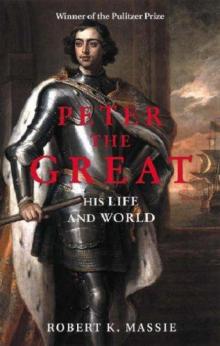 Peter the Great
Peter the Great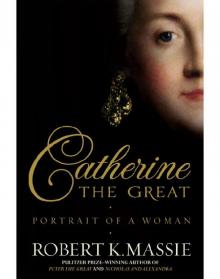 Catherine the Great
Catherine the Great Dreadnought
Dreadnought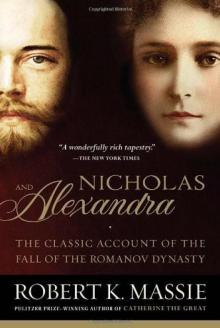 Nicholas and Alexandra: The Classic Account of the Fall of the Romanov Dynasty
Nicholas and Alexandra: The Classic Account of the Fall of the Romanov Dynasty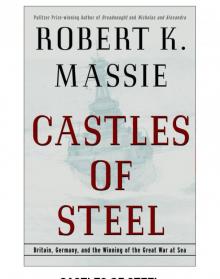 Castles of Steel
Castles of Steel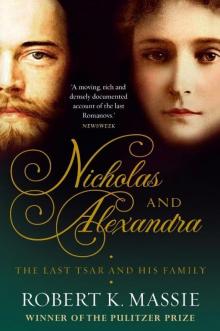 Nicholas and Alexandra: The Tragic, Compelling Story of the Last Tsar and his Family
Nicholas and Alexandra: The Tragic, Compelling Story of the Last Tsar and his Family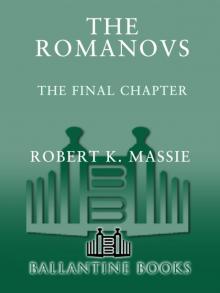 The Romanovs
The Romanovs Dreadnought, Britain, Germany and the Coming of the Great War
Dreadnought, Britain, Germany and the Coming of the Great War Nicholas and Alexandra
Nicholas and Alexandra